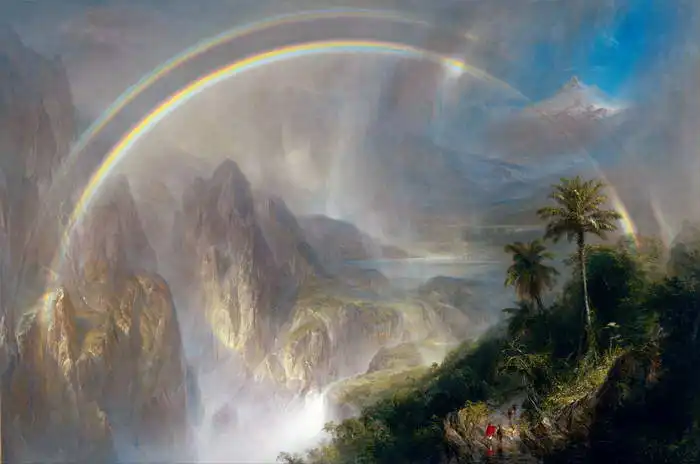About this finishing
Print. The image is printed on the top quality 10-ink HP Z9PS printer on HP matte 270 g / m2 paper. You can choose any size to an accuracy of 1 cm. A margin of 5 cm around the image is added to the size of the motif.


You can find a detailed description about our finishings
here.
Rainy season
Date:
1866Location:
Fine Arts Museums of San Francisco"Rainy Season in the Tropics" stands as one of the most acclaimed pieces by
Frederic Edwin Church , an artist of the second generation of the Hudson River School. Despite its theatrical and
symbolic nature,
the landscape incorporates scientifically accurate elements. The double rainbow, notably featuring the reversal of the color spectrum known as Alexander's band, indicates Church's meticulous observation and potential consultation of scientific references. The tropical flora depicted in the painting originates from botanical sketches Church created during his time in Jamaica. Painted after a challenging period in the artist's life, including the loss of two children, the artwork is often seen as a reflection of Church's renewed optimism, both personally and in the context of a unified nation after the American Civil War.
Church painted picture Rainy season in 1866. Prevailing color of this fine art print is vivid and its shape is landscape. This art piece is located in Fine Arts Museums of San Francisco. This image is printed on demand - you can choose material, size and finishing.
Frederic Edwin Church (1826-1900) was an American
Romantic landscape painter born in Hartford, Connecticut. His father was a watchmaker and his younger brother founded the first paper mill in Lee, Massachusetts in Berkshires. A good background allowed him to pursue art from early childhood. At 18, he was the youngest worker in the National Academy of Design and a year later, he was awarded an academic title. He was the only student of Thomas Cole. Church’s style is evident in his paintings: rich representation of red, purple and orange, and the emphasis on imagination. Connections with rich customers enabled him to embark on two trips throughout South and North America. There, he could capture the beauty of the natural scenery in Ecuador during the
rainy season or the splendor of
Niagara Falls. Aurora borealis is a spectacular picture that leaves the viewer almost breathless. One of the four paintings from the series The Hearth of the Andes won him fame during the 1859 exhibition. He specialized also in faithful representations of Ecuadorian flora. His art is highly regarded not only in America.


